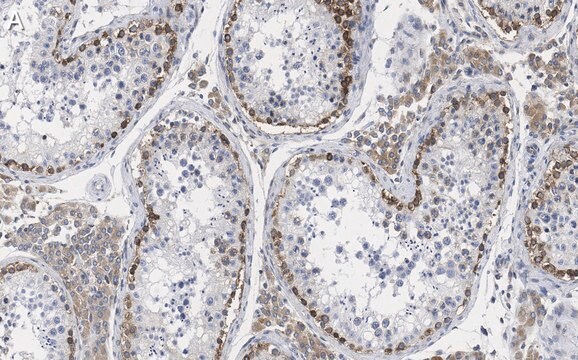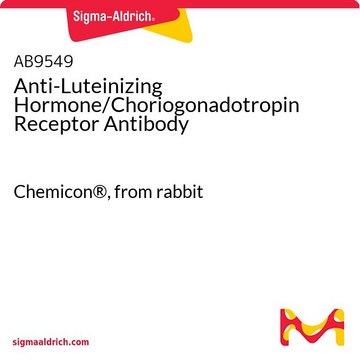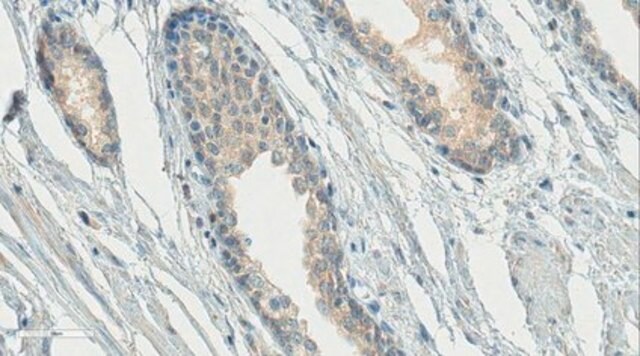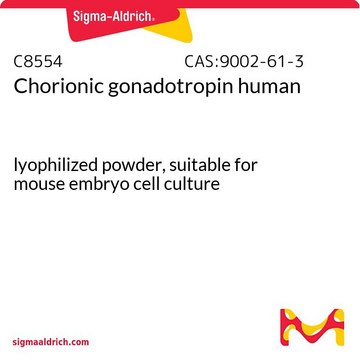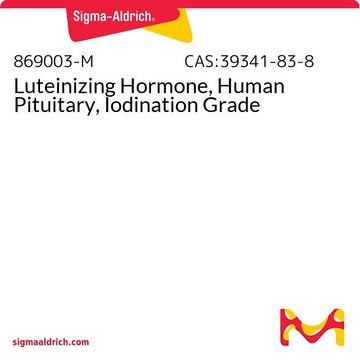MABN1794
Anti-GnRH-R Antibody, clone F1G4
clone FIG4, from mouse
Synonim(y):
Gonadotropin-releasing hormone receptor, GnRH receptor, GnRH-R, Leutinizing hormone-releasing hormone receptor, Luteinizing-releasing hormone receptor
About This Item
Polecane produkty
pochodzenie biologiczne
mouse
Poziom jakości
forma przeciwciała
purified immunoglobulin
rodzaj przeciwciała
primary antibodies
klon
FIG4, monoclonal
reaktywność gatunkowa
human
metody
ELISA: suitable
dot blot: suitable
flow cytometry: suitable
immunohistochemistry: suitable (paraffin)
western blot: suitable
izotyp
IgG1λ
numer dostępu NCBI
numer dostępu UniProt
Warunki transportu
wet ice
docelowa modyfikacja potranslacyjna
unmodified
informacje o genach
human ... GNRHR (2798)
Opis ogólny
Specyficzność
Immunogen
Zastosowanie
ELISA Analysis: A representative lot detected the immobilized immunogen peptide by ELISA (Karande, A.A., et al. (1995). Mol. Cell. Endocrinol. 114(102):51-56).
Flow Cytometry Analysis: A representative lot detected surface GnRH-R immunoreactivity on live human breast carcinoma T47D and ovarian carcinoma OVCAR-3 cells. Most likely due to low affinity antibody binding or unoptimized antibody concentration used, only ~50% of the T47D and ~10% of the OVCAR-3 populations were stained (Karande, A.A., et al. (1995). Mol. Cell. Endocrinol. 114(102):51-56).
Immunohistochemistry Analysis: A rerepsentative lot detected GnRH-R expression on gonadotropin-producing endocrine cells (gonadotropes) in pituitary, as well as among neurons in human hippocampus and neocortex, using formalin-fixed, paraffin-embedded human tissue sections (Wilson, A.C., et al. (2006). J. Endocrinol. 191(3):651–663).
Immunohistochemistry Analysis: A rerepsentative lot detected similar hippocampus GnRH-R immunoreactivity among Alzheimer′s diseased (AD) and age-matched control brain sections, while significanly decreased GnRH-R immunoreactivity associated with the apical dendrites of pyramidal neurons was seen in the AD brain using formalin-fixed, paraffin-embedded tissue sections (Wilson, A.C., et al. (2006). J. Endocrinol. 191(3):651–663).
Immunohistochemistry Analysis: A rerepsentative lot detected GnRH-R-positive cells in the anterior pituitary, but not the posterior pituitary using frozen human brain sections. Pre-blocking with immunogen peptide abolished the antibody staining (Karande, A.A., et al. (1995). Mol. Cell. Endocrinol. 114(102):51-56).
Western Blotting Analysis: A rerepsentative lot detected the expression of multiple GnRH-R variants in human cortex and pituitary tissue lysates, including the most prominent 30 kDa, 64 kDa, and 136 kDa bands. The 136 kDa band was seen significantly downregulated in the cortex, but not pituitary from Alzheimer′s diseased (AD) brain when compared to age-matched control (Wilson, A.C., et al. (2006). J. Endocrinol. 191(3):651–663).
Neuroscience
Hormones & Receptors
Jakość
Western Blotting Analysis: 2.0 µg/mL of this antibody detected GnRH-R in 10 µg of human pituitary tissue lysate.
Opis wartości docelowych
Postać fizyczna
Przechowywanie i stabilność
Inne uwagi
Oświadczenie o zrzeczeniu się odpowiedzialności
Nie możesz znaleźć właściwego produktu?
Wypróbuj nasz Narzędzie selektora produktów.
Kod klasy składowania
12 - Non Combustible Liquids
Klasa zagrożenia wodnego (WGK)
WGK 1
Temperatura zapłonu (°F)
Not applicable
Temperatura zapłonu (°C)
Not applicable
Certyfikaty analizy (CoA)
Poszukaj Certyfikaty analizy (CoA), wpisując numer partii/serii produktów. Numery serii i partii można znaleźć na etykiecie produktu po słowach „seria” lub „partia”.
Masz już ten produkt?
Dokumenty związane z niedawno zakupionymi produktami zostały zamieszczone w Bibliotece dokumentów.
Nasz zespół naukowców ma doświadczenie we wszystkich obszarach badań, w tym w naukach przyrodniczych, materiałoznawstwie, syntezie chemicznej, chromatografii, analityce i wielu innych dziedzinach.
Skontaktuj się z zespołem ds. pomocy technicznej

